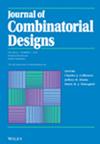扩展近Skolem序列,第三部分
IF 0.5
4区 数学
Q3 MATHEMATICS
引用次数: 2
摘要
一个k $k$‐扩展q $q$‐阶为n $n$的近Skolem序列,用Nnq(k) ${{\mathscr{N}}}_{n}^{q}(k)$表示,是一个序列s1,s2,…,s2n−1 ${s}_{1},{s}_{2},\ldots ,{s}_{2n-1}$,其中sk=0 ${s}_{k}=0$,对于每个整数,∈[1,n]{q} $\ell \in [1,n]\backslash \{q\}$,有两个索引i $i$, j $j$,使得si=sj=∑${s}_{i}={s}_{j}=\ell $和∣i−j∣=∑$| i-j| =\ell $。要使Nnq(k) ${{\mathscr{N}}}_{n}^{q}(k)$存在,则当n≡0,1(mod4) $n\equiv 0,1\,(\mathrm{mod}\,4)$时,q≡k(mod2) $q\equiv k\,(\mathrm{mod}\,2)$;当n≡2,3(mod4) $n\equiv 2,3\,(\mathrm{mod}\,4)$,且(n,q,k)≠(3,2,3)$(n,q,k)\ne (3,2,3)$, (4,2,4) $(4,2,4)$时,q≡k(mod2) $q\not\equiv k\,(\mathrm{mod}\,2)$。任何满足这些条件的三元组(n,q,k) $(n,q,k)$都是可容许的。在这个手稿中,这是三个手稿的第三部分,我们构建了剩余的序列;即Nnq(k) ${{\mathscr{N}}}_{n}^{q}(k)$对于所有允许的(n,q,k) $(n,q,k)$,其中q∈⌊n+23⌋,⌊n−22⌋$q\in \left[\lfloor \frac{n+2}{3}\rfloor ,\lfloor \frac{n-2}{2}\rfloor \right]$,k∈⌊2n3⌋,n−1 $k\in \left[\lfloor \frac{2n}{3}\rfloor ,n-1\right]$。本文章由计算机程序翻译,如有差异,请以英文原文为准。
Extended near Skolem sequences, Part III
A k $k$ ‐extended q $q$ ‐near Skolem sequence of order n $n$ , denoted by Nnq(k) ${{\mathscr{N}}}_{n}^{q}(k)$ , is a sequence s1,s2,…,s2n−1 ${s}_{1},{s}_{2},\ldots ,{s}_{2n-1}$ where sk=0 ${s}_{k}=0$ and for each integer ℓ∈[1,n]\{q} $\ell \in [1,n]\backslash \{q\}$ there are two indices i $i$ , j $j$ such that si=sj=ℓ ${s}_{i}={s}_{j}=\ell $ and ∣i−j∣=ℓ $| i-j| =\ell $ . For an Nnq(k) ${{\mathscr{N}}}_{n}^{q}(k)$ to exist it is necessary that q≡k(mod2) $q\equiv k\,(\mathrm{mod}\,2)$ when n≡0,1(mod4) $n\equiv 0,1\,(\mathrm{mod}\,4)$ and q≢k(mod2) $q\not\equiv k\,(\mathrm{mod}\,2)$ when n≡2,3(mod4) $n\equiv 2,3\,(\mathrm{mod}\,4)$ , where (n,q,k)≠(3,2,3) $(n,q,k)\ne (3,2,3)$ , (4,2,4) $(4,2,4)$ . Any triple (n,q,k) $(n,q,k)$ satisfying these conditions is called admissible. In this manuscript, which is Part III of three manuscripts, we construct the remaining sequences; that is, Nnq(k) ${{\mathscr{N}}}_{n}^{q}(k)$ for all admissible (n,q,k) $(n,q,k)$ with q∈⌊n+23⌋,⌊n−22⌋ $q\in \left[\lfloor \frac{n+2}{3}\rfloor ,\lfloor \frac{n-2}{2}\rfloor \right]$ and k∈⌊2n3⌋,n−1 $k\in \left[\lfloor \frac{2n}{3}\rfloor ,n-1\right]$ .
求助全文
通过发布文献求助,成功后即可免费获取论文全文。
去求助
来源期刊
CiteScore
1.60
自引率
14.30%
发文量
55
审稿时长
>12 weeks
期刊介绍:
The Journal of Combinatorial Designs is an international journal devoted to the timely publication of the most influential papers in the area of combinatorial design theory. All topics in design theory, and in which design theory has important applications, are covered, including:
block designs, t-designs, pairwise balanced designs and group divisible designs
Latin squares, quasigroups, and related algebras
computational methods in design theory
construction methods
applications in computer science, experimental design theory, and coding theory
graph decompositions, factorizations, and design-theoretic techniques in graph theory and extremal combinatorics
finite geometry and its relation with design theory.
algebraic aspects of design theory.
Researchers and scientists can depend on the Journal of Combinatorial Designs for the most recent developments in this rapidly growing field, and to provide a forum for both theoretical research and applications. All papers appearing in the Journal of Combinatorial Designs are carefully peer refereed.

 求助内容:
求助内容: 应助结果提醒方式:
应助结果提醒方式:


